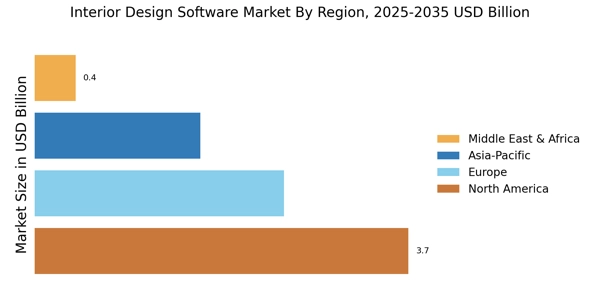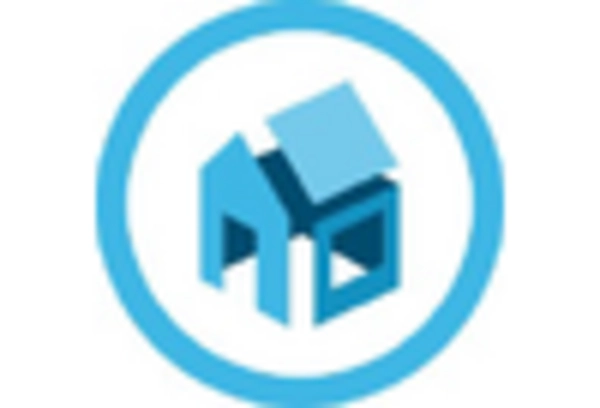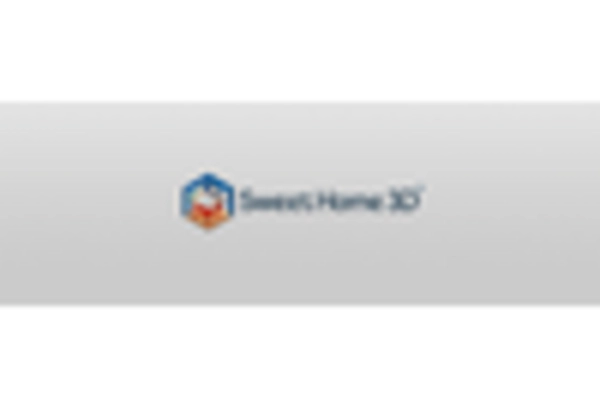Increased Demand for Home Renovation
The Interior Design Software Market experiences a notable surge in demand driven by the increasing interest in home renovation projects. As homeowners seek to enhance their living spaces, the need for effective design tools becomes paramount. According to recent data, the home renovation market is projected to reach substantial figures, indicating a robust growth trajectory. This trend is further fueled by the rise of DIY culture, where individuals prefer to take on design projects themselves. Consequently, software solutions that offer user-friendly interfaces and comprehensive design features are likely to gain traction. The ability to visualize changes in real-time and access a plethora of design templates enhances the appeal of these tools, making them indispensable for both amateur and professional designers alike.
Rise of Collaborative Design Platforms
The rise of collaborative design platforms is significantly influencing the Interior Design Software Market. As design projects often involve multiple stakeholders, the need for tools that facilitate collaboration has become increasingly apparent. These platforms enable designers, clients, and contractors to work together in real-time, streamlining the design process and improving communication. Market trends suggest that the adoption of collaborative tools is on the rise, as they enhance efficiency and reduce the likelihood of miscommunication. By allowing all parties to contribute and provide feedback throughout the design process, these platforms foster a more inclusive approach to interior design. As the demand for collaborative solutions grows, software that integrates these functionalities is expected to see increased adoption, further driving market growth.
Technological Advancements in Design Tools
Technological advancements play a crucial role in shaping the Interior Design Software Market. The integration of cutting-edge technologies such as augmented reality and 3D modeling has revolutionized the way designers conceptualize and present their ideas. These innovations allow for immersive experiences, enabling clients to visualize their spaces before any physical changes are made. Market data suggests that the adoption of such technologies is on the rise, with a significant percentage of designers incorporating them into their workflows. This shift not only enhances the design process but also improves client satisfaction, as clients can engage with their projects in a more interactive manner. As technology continues to evolve, the demand for sophisticated design software that leverages these advancements is expected to grow, further propelling the market forward.
Growing Popularity of Online Design Services
The Interior Design Software Market is witnessing a growing popularity of online design services, which cater to a diverse clientele seeking convenience and accessibility. With the proliferation of internet access and mobile devices, consumers are increasingly turning to online platforms for design solutions. This trend is reflected in the rising number of virtual design consultations and remote collaboration tools that facilitate seamless communication between designers and clients. Market analysis indicates that this shift towards online services is likely to continue, as it offers flexibility and cost-effectiveness. Additionally, the ability to access a wide range of design resources and tools from anywhere enhances the appeal of these services. As more individuals embrace the convenience of online design, the demand for software that supports these functionalities is expected to increase, driving growth in the market.
Emphasis on User Experience and Customization
User experience and customization are becoming increasingly important in the Interior Design Software Market. As designers and clients seek tailored solutions that meet their specific needs, software developers are focusing on creating platforms that offer extensive customization options. This emphasis on personalization allows users to adapt tools to their unique design preferences and workflows. Market data indicates that software solutions that prioritize user-friendly interfaces and intuitive navigation are more likely to attract a larger user base. Furthermore, the ability to customize features and templates enhances the overall design experience, making it more enjoyable and efficient. As the demand for personalized design solutions continues to rise, software providers that prioritize user experience are likely to gain a competitive edge in the market.


















Leave a Comment